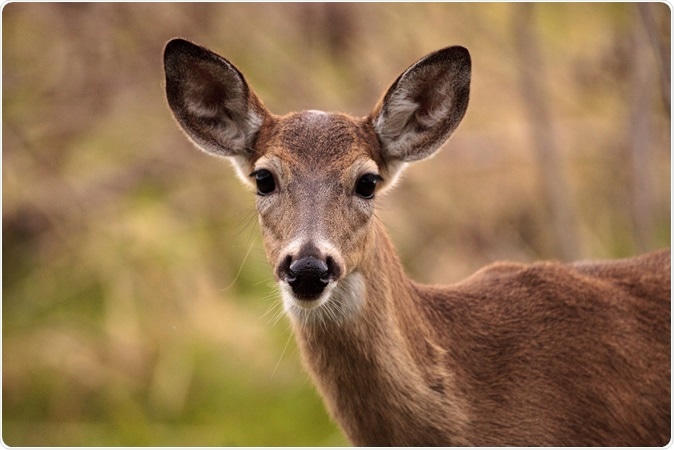Chronic wasting disease of the deer - source identified
Chronic wasting disease of the deer or CWD has been nicknamed “Zombie deer disease”. It has been affecting deer across Pennsylvania and has also been noted in Lancaster County. According to Dr. Frank Bastian, a neuropathologist and animal scientist with Louisiana State University, the source of the disease was unknown and misdiagnosed until now.

White-tailed deer. Image Credit: LagunaticPhoto / Shutterstock
The deer-hunting industry is worth $1.8-billion in Pennsylvania and is a cottage industry in Lancaster County where there are several deer farms. In 1981, the first wide deer infected with CWD was found and reported. In 2012 an infected deer was found in Pennsylvania at a deer farm in Adams County. More wild deer with the condition were detected in 2012 in Blair and Bedford counties. Three deer were found at a farm in Denver and thus a quarantine zone was declared in regions of northern Lancaster County, Berks and Lebanon. This quarantine meant that the hunters had to submit the heads of their previous season kills for testing. In this drive a total of around 345 deer heads were collected. The Pennsylvania Game Commission says that none of the wild deer heads were found to be infected.
Dr. Frank Bastian has now claimed to have found the real cause behind CWD. Until now it has been believed that CWD in deer is akin to mad-cow disease or Creutzfeldt Jacob disease or sheep scrapie caused by altered brain protein fragments called prions. This theory was put forth by Neurologist Dr. Stanley Prusiner who won the Nobel Prizefor this in 1997. The prion theory is accepted by the U.S. Centers for Disease Control and Prevention and the U.S. Fish and Wildlife Service.
Bastian and Unified Sportsmen of Pennsylvania however believe that the prion theory is not applicable for the CWD in deer. Bastian claims that there is a microbe – a bacterium that causes the disease. The prion proteins are the bacterial by-products that are found in deer brain with chronic wasting disease he explained and thus not the cause of the condition. Bastian and his team have grown the bacteria in the lab and are working towards developing a vaccine against it and an appropriate antibiotic to kill it and prevent the disease and also treat it among wild as well as captive deer. The results of the study isolating the bacterium in the labs were published in 2017 in the Journal of Neuropathology and Experimental Neurology.
Bastian is also developing a simple test kit that hunters can carry into the woods to test their kill for the infection. If they detect the infection, they could take the decision of not consuming the kill and also dispose of the infected animal appropriately, he explained.
The Unified Sportsmen of Pennsylvania have called Bastian’s theory a “game changer” and a “breakthrough”. Stephen Mohr of Bainbridge, chairman of the Unified Sportsmen of Pennsylvania board said in a statement, “We need answers now. Time is running out. Once CWD hits the Pennsylvania elk herd, it is over. They will be totally gone in 10 years or less.”
The Game Commission and the state Department of Agriculture however are still with the prion theory. Courtney Colley, chronic wasting disease communications specialist from the Game Commission said, “One of the first things to point out is that the Game Commission would welcome any successful effort by any researcher that will provide a test for CWD.” She said that if a vaccine was being developed against the disease, it was welcome news. She added however, “the one thing about Dr. Bastian’s research is that no one has been able to replicate it. No wildlife agency accepts the bacteria theory. As a state wildlife agency that manages wildlife in Pennsylvania, it would really be irresponsible of us not to follow the most widely accepted scientific research which is that prions are the cause of chronic wasting disease.”
Fear of CWD deer to jump to humans
There is a growing fear that consuming deer meat that is infected with CWD could transmit it to the humans. Experts from the University of Minnesota have urged health officials to treat this as a public health concern and take action. The spread of the disease is from Minnesota in the southeast portion of the state, including Winona County. Up until now no human cases of the infection have been reported.
Michael Osterholm, director for the University of Minnesota’s Center for Infectious Disease Research and Policy chaired the panel of experts who looked at the similar growth and development of mad cow disease a few decades previously. Osterholm said, “It is my best professional judgment based on my public health experience and the risk of BSE (bovine spongiform encephalopathy) transmission to humans in the 1980s and 1990s and my extensive review and evaluation of laboratory research studies ... that it is probable that human cases of CWD associated with the consumption of contaminated meat will be documented in the years ahead. It is possible that number of human cases will be substantial and will not be isolated events.”
The U.S. Centers for Disease Control and Prevention and the World Health Organization have urged people to refrain from eating deer meat contaminated with the infection. At present only around 1 percent of the deer in Fillmore County are infected with CWD say the wildlife officials. In Wisconsin however, the rates are higher – up to 35 percent among deer populations.